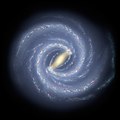| Okroy Cloud | |
|---|---|
 | |
| Observation data (J2000 epoch) | |
| Constellation | Virgo |
| Right ascension | 12h 50m |
| Declination | 22° |
| Distance | ? |
| Apparent magnitude (V) | ? |
| Absolute magnitude (V) | ? |
| Characteristics | |
| Type | intergalactic dust cloud |
| Apparent size (V) | 30° × 10° |
| Other designations | |
| none | |
The Okroy Cloud, is an intergalactic dust cloud near the Milky Way galaxy and is possible a satellite of the galaxy due to its low velocity. Its intergalactic nature was first studied by Bogdan Wszolek and Solvia Massi in 1988. [1]
